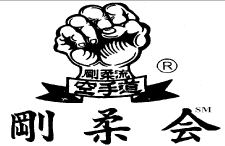Goju-ryu karate contains five progressive programs of instruction. The
first is devoted to the warming up exercises used by the goju practitioner. The second,
called kihon, or
î{
deals with the fundamentals of blocking, striking and kicking.
From kihon, the student progress to kihon ido, or
î{Ú®
which leads into the two
major programs, kata and kumite. Kata is the aesthetic, ballet-like exercise composed of
serial patterns. Kumite is the combative, combined-pattrern exercise also referred to as
sparring.
Both series of kata ido and nekoashi ido belong to the same category of
kihon ido- that of the ido (movement) program. However, they are preparatory programs
which function as transitional exercises between the basic programs and the programs of
kata and kumite. Kata ido is programmed to facilitate the turning exercises in preparation
for fukyu gata, or y`, whereas, nekoashi ido is programmed toward footwork
exercises in preparation for kumite, or gè.
@
The kihon series combines the basic blocking, striking and kicking
techniques with basic stances and postures. Because the kihon forms are performed one
stance at a time, they are called stationary activity. Although the feet may move to kick
during the excution of a form, they return to their original stance upon completion of the
technique. Therefore, like the geometric definition of the dot, kihon is characterized by
"dimensionless space".
Kihon ido then puts the forms learned in kihon into simple patterns of
movement. These patterns consist of forward and backward movements in straight lines. In
geometric terminology kihon ido is characterized by "line demention".
When the student reaches the kata and kumite programs, he performs his
footwork in any direction of plane areas. In other words, the instructional process of
goju-ryu is a progressive sequence of dimensional expansions - dots to lines to planes.
The following list shows the order of the goju-ryu programs.
PROGRAMS
1. Group 1:
Warm-up Exercises i\õ^®j
2. Group 2:
Kihon (î{)
Kihon I, Kihon II, Kihon III,
Kihon IV
3. Group 3:
Ido (Ú®)
Kihon Ido, Kata Ido,
Kumite Ido
4. Group 4:
Katai`j
Fukyu Gataiy`j
1) Taikyoku Jodan (I and II) åÉãi
2) Taikyoku Chudan (I and II) åÉi
3) Taikyoku Gedan åɺi
4) Taikyoku Kake-Uke (I and II) åÉ|ó
5) Taikyoku Mawashi-Uke (I and II) åÉôó
6) Gekisai (I and II) Ç
Kihon Gataiî{`j
1) Sanchin Oí 2) Tensho ]¶
Kaishu Gata (Jè`j
1) Saifa TCt@
2) Seinchin ZC`
3) Sanseiru TZCE
4) Shisochin V\E`
5) Seisan ZCT
6) Seipai ZCpC
7) Kururunfa Nt@
WjSuparunpei XEpAyC
@

@
